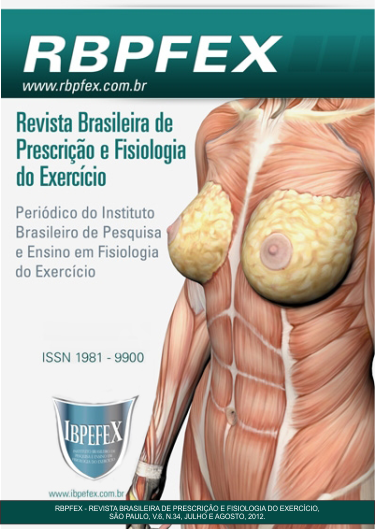Resistive circuit promotes exercise reduction of blood glucose in diabetic acute non-insulin-dependent
Abstract
Despite the advancement of research in relation to the value of resistance exercise in the overall treatment of type 2 diabetes , little is known about the profiles of acute glycemic response in these individuals, the different resistance training protocols. Given the dearth of study of this proposition, our study aims to determine the acute glycemic impact of a session of resistance exercise circuit consisting of twelve exercises, conducted alternately by muscle group, performed in a single lap on the circuit with 20 submaximal repetitions in diabetic non-insulin dependent. We recruited 10 sedentary volunteers of both sexes, with at least 2 years of diagnosis of the disease, which only made use of oral hypoglycemic agents for glycemic control. The results showed significant difference (p <0.05) between the pre-exercise 203 mg/dl and post-exercise 161 mg/dl, a reduction of 20.7%, allowing us to conclude that resistance exercise sessions performed under the method of circuit, with moderate intensity and submaximal repetitions, further significant reductions of blood glucose monitoring and can be prescribed without metabolic risk for diabetic non-insulin dependent
References
-Albright, A.; Franz, M.; Hornsby, G.; Kriska, A.; Marrero, D.; Ullrich, I.; Verity, L.S. American College of Sports Medicine position stand. Exercise and type 2 diabetes. Medicine and Science in Sports and Exercice. Vol. 32. Num. 7. 2000.
-Baldi, J.C.; Snowling, N. Resistance training improves glycaemic control in obese type 2 diabetic men. International Journal of Sports Medicine. Vol. 24. Num. 6. 2003.
-Bassuk, S.S.; Manson, J.E. Epidemiological evidence for the role of physical activity in reducing risk of type 2 diabetes and cardiovascular disease. Journal of Applied Physiology. Vol. 99. Num. 3. p. 1193-1204. 2005.
-Davi, J.K.; Green, J.M. Resistance Training and Type-2 Diabetes. Strength and Conditioning Journal.2007.
-De Agostini, G.G.; Barros, C.L.M.; Garcia, E.S.; Baldissera, V. Limiar de lactato em exercício resistido. Motriz. Rio Claro. Vol. 10. Num. 1. p. 31-36. 2004.
-Denadai, B.S. Limiar anaeróbio: Considerações Fisiológicas e Metodológicas, Revista Brasileira de Atividade Física e Saúde, Vol. 1, Num. 2. 1995.
-Dunstan, D.W.; Puddey, I.B.; Beilin, L.J.; Burke, V.; Morton, A.R.; Stanton, K.G. Effects of a short-term circuit weight training programo n glycaemic control in NIDDM. Diabetes Research and Clinical Practice. Amsterdam. Vol. 40. p. 53-61. 1998.
-Eriksson, J.; Taimela, S.; Eriksson, K.; Parviainen, S.; Peltronen, J.; Kujuala, U. Resistance Training in the Treatment of Non-Insulin DependentDiabetes Mellitus. International of Sports Medicine. Vol. 18. Num. 4. 1997.
-Fenicchia, L.M.; Kanaley, J.A.; Azevedo Junior, J.L.; Miller, C.S.; Weinstock, R.S.; Carhart, R.L.; Ploutz-Snyder, L.L. Influence of resistance exercise training on glucose control in women with type 2 diabetes. Metabolism. Vol. 53, Num. 3. p. 284-289. 2004.
-Goodyear, L.J.; Hirshman, M.F.; Horton, E.S. Exercise-induced translocation of skeletal muscle glucose transporters. The American Journal of Physiology. Vol. 261. 1991.
-Graves, J.E.; Franklin, B.A. Treinamento Resistido na Saúde e Reabilitação. Revinter, 2006.
-Ivy, J.L. Role of exercise training in the prevention and treatment of insulin resistance and non-insulin-dependent diabetes mellitus. Sports Medicine. Vol. 24. Num. 5. p. 321-36. 1997.
-Izquierdo, M.; Ibañez, J.; Calbet, J.A.; Navarro-Amezqueta, I.; González-Izal, M.; Idoate, F.; Häkkinen, K.; Kraemer, W.J.; Palacioss-Sarrasqueta, M.;Almar, M.; Gorostiaga, E.M. Cytokine and hormone responses to resistancetraining. European Journal of Applied Physiology. Vol. 107. Num. 4. p. 397-409. 2009.
-LaMonte, M.J.; Blair, S.N.; Church, T.S. Physical activity and diabetes prevention. Journal of Applied Physiology. Vol. 99. p. 1205-1213. 2005.
-Lara, F.N. O efeito agudo do exercício de força e da caminhada, na glicemia de um indivíduo sedentário diabético do tipo 2. Revista Brasileira de Prescrição e Fisiologia do Exercício. Vol. 3. Num. 15. p. 248-254. 2009.
-Lopes, M.B.M.; Sangelmi, M.V.S.; Lima, W.P. Efeito agudo da glicemia capilar em diabéticos tipo ii entre uma sessão de hidroginástica e outra de ginástica aeróbica. Revista Brasileira de Prescrição e Fisiologia do Exercício. São Paulo. Vol. 3. Num. 13. p. 78-83. 2009.
-Miller, J.P.; Pratley, R.E.; Goldberg, A.P.; Gordon, P.; Rubin, M.; Treuth, M.S.; Ryan, A.S.; Hurley, B.F. Strength training increases insulin action in healthy 50-to 65-yr-old men. Journal of Applied Physiology. Vol. 77. Num. 3. p. 1122-7. 1994.
-Pereira, L.O.; Lancha Junior, A. H. Effect of insulin and contraction up on glucose transport in skeletal muscle. Progress in Biophysics and Molecular Biology. USA. Vol. 84. p. 1-27, 2004.
-Sakamoto, K.; Goodyear, L.J. Invited review: intracellular signaling in contracting skeletal muscle. Journal of Applied Physiology. Vol. 93, Num. 1. 2002.
-Schneider, S.H.; Khachadurian, A.K.; Amorosa, L.F.; Clemow, L.; Ruderman, N.B. Ten-year experience with an exercise-based outpatient life-style modification program in the treatment of diabetes mellitus. Diabetes Care. Vol. 15. Num. 11. p. 1800-10. 1992.
-Scott, C.B. Contribuition of blood lactate to the energy expenditure of weight training. Journal of Strength and Conditioning Research. Vol. 20. Num. 2. p. 404-11. 2006.
-Simões, H.G.; Grubert Campbell, C.S.; Kokubun, E.; Denadai, B.S.; Baldissera, V. Blood glucose responses in humans mirror lactate responses for individual anaerobic threshold and for lactate minimum in track tests. European Journal of Applied Physiology. Vol. 80. Num. 1. p. 34-40. 1999.
Authors who publish in this journal agree to the following terms:
- Authors retain the copyright and grant the journal the right of first publication, with work simultaneously licensed under the Creative Commons Attribution License BY-NC which allows the sharing of the work with acknowledgment of the authorship of the work and initial publication in this journal.
- Authors are authorized to enter into additional contracts separately for non-exclusive distribution of the version of the work published in this journal (eg, publishing in institutional repository or book chapter), with acknowledgment of authorship and initial publication in this journal.
- Authors are allowed and encouraged to post and distribute their work online (eg, in institutional repositories or on their personal page) at any point before or during the editorial process, as this can bring about productive change as well as increase impact and impact. citation of published work (See The Effect of Free Access).






